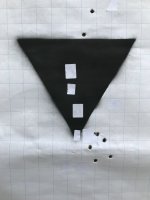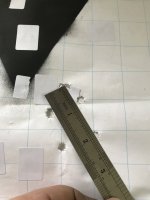I’ve hunted deer with fed blue box, which is a hot core bullet. Great performance and accuracy in my one no.4, I would have no problem buying them as components.
I have been shooting 180gr sp jacketed campro’s out of a different no.4 with BL-C2, more than acceptable accuracy at 100m so far. Wish they still made that bullet, or I had bought another sac of them.
Campro’s @ 100m, haven’t played with seating depth yet. This was initial ladder tests, shows so promise.
View attachment 897013
View attachment 897014
BLC-2 is a great powder for the 303 Brit and similar capacity cartridges with 150+ grain bullets, which is what the parent BLC was designed for If memory serves It started life as WC846.
I still have about ten pounds of the original BLC, which is a bit slower than BLC2.
From war to shooting sports
“As early as 1947 (the year Grandad Bruce founded Hodgdon), we were aware of a big surplus of .303 British ammunition,” Chris Hodgdon told me in an email exchange. “Bruce purchased the salvaged, demilled powder from Olin Matheson Chemical Company and resold it as Western Ball Type C. Grandad thought this particular powder was cooler burning in his 22-250, so that’s where the ‘C’ part came to be.”
Hodgdon’s first commercial incarnation of milsurp 303 British powder: BL-Type, a then-newfangled spherical powder. (Chris Hodgdon photo)
The “C” part is apparently also due to trademark concerns. Because Olin owned and still owns trademark to “Western” and “Ball” in regards to smokeless powders, Hodgdon changed the powder’s name from Western Ball Type C to “BL Type C” or, “BL-C.” Due to its cooler burn being kind to chamber throats, its smooth metering and its fairly wide application in small to medium size rifle cartridge cases, BL-C quickly gained popularity among handloaders.
“Hundreds, if not thousands of shooters won many precision rifle matches using it through the 1950s and 60s,” Chris said. “It is still highly coveted by those lucky enough to find it.” As an aside, in that statement we find the answer to the oft-asked question, “How long do smokeless powders last before they go bad?”
Hodgdon purchased 80 tons of the surplus powder and started selling BL-C in 1949; by 1961 the 80 tons had diminished by the pound and keg, so Hodgdon replaced the milsurp powder with a newly manufactured version, BL-C (Lot #2). Hodgdon claimed the new version was cleaner-burning than BL-C; burn rate is close to the original BL-C, but BL-C and BL-C (2) are not identical and data between the two are not interchangeable. Since introduction, many handloaders have verbalized the “BL” as “Ball,” as in, “Ball-C Two.”
The new (2)
In burn rate, Hodgdon BL-C (2) is in the same neighborhood as Norma 201, Winchester 748 and Reloader 12. A perusal of a half-dozen reloading manuals, current and a bit older, show BL-C (2) suggested loads for cartridges starting from 17 Fireball, becoming quite popular for the .22s and then petering out at about the 7mm Mauser except for a smattering of .30 caliber loads with light-for-caliber bullets. Interestingly, only one manual, Hornady’s 4th Edition, listed a BL-C (2) load for the 303 British.
BL-Type was so popular that, when Hodgdon ran out of all eight tons, they commissioned a commercial replacement in the 1960s, Lot #2 of BL-C.
Obviously, the difference between BL-C and BL-C (2), as well as the plethora of powder choices today, has favored BL-C (2) toward smaller cases. This is perhaps borne out by a 1950s BL-C load (Speer) for the 7mm Mashburn Magnum, essentially a necked-down and blown-out, cavernous 300 H&H belted magnum case. The load, 62-gr. under a Speer 130-gr. bullet, if you’re curious, lists a muzzle velocity of 3150fps. That’s the largest cartridge case for which I found a BL-C load.
In general, BL-C (2) loads appear to somewhat trend in this way: in the smallest cases, it shows up under the heavier bullets for that cartridge; as we progress into larger cases, it tends toward loads for the lighter bullets. But that’s not a hard and fast rule. Confining ourselves to just the current Sierra manual (5th Edition), in one exception Sierra lists a 308 Win BL-C(2) load for the 190-gr. bullet – definitely a super heavyweight for that cartridge. Then moving up to the 30-06 Ackley Improved, only the light, 125-gr. bullet utilizes BL-C (2). In cartridges larger than .30 caliber, BL-C(2) shows up in the 8mm-06 and 35 Remington with 200-gr. bullets, and in the 358 Winchester with 200-gr. and 225-gr. bullets, the latter being the largest cartridge in the Sierra manual that includes a BL-C(2) listing.
BL-C(2) first appears in the current Sierra manual with the 219 Donaldson Wasp; while starting there and running up to the 358 Win covers a lot of territory, in reality BL-C(2) skips over many cartridges. Its comfy home seems to be on the non-magnum .22s.










































































